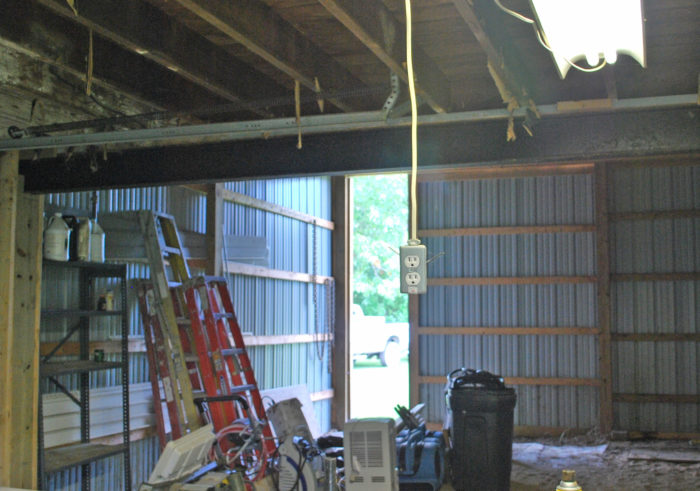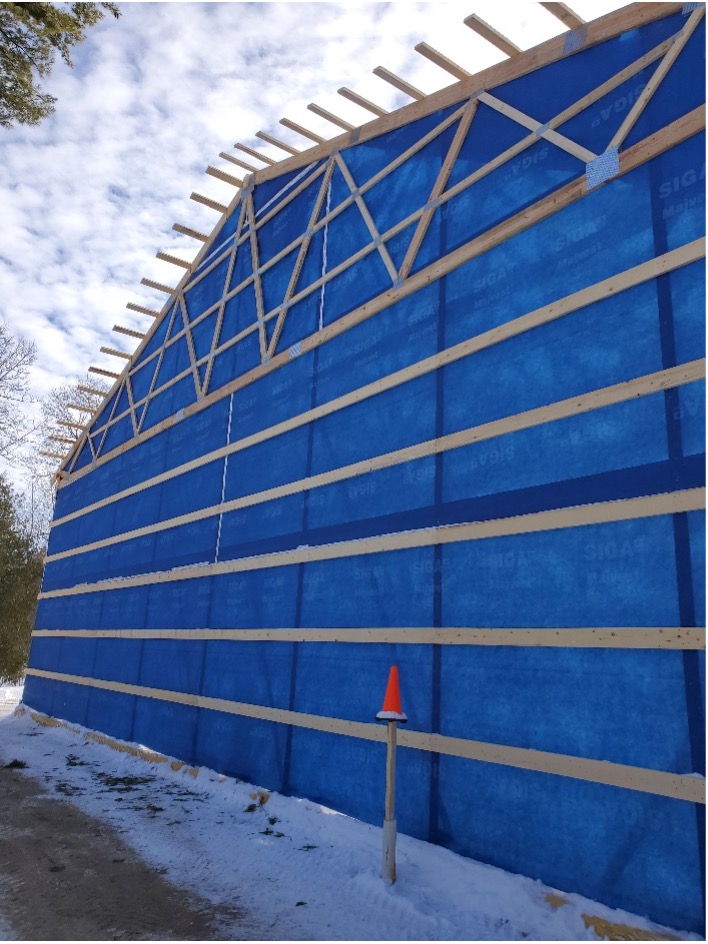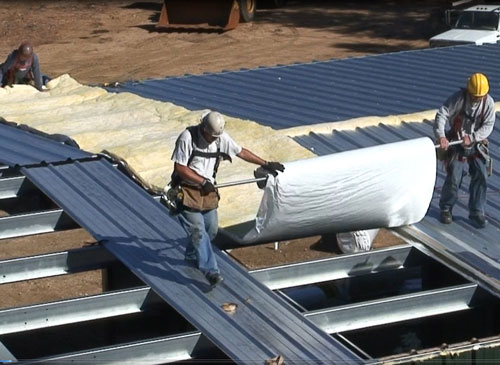
In its most basic form, a pole barn is a fairly simple agricultural building or storage structure with widely spaced posts rather than studs for framing. Back in the 1930s, farmers often used old utility poles to build these buildings. Since the poles were usually deeply buried (typically 4 to 6 feet deep), they provided both foundation and vertical structure.
These days, most pole barns are more sophisticated than the dirt-floored pole barns of the 1930s. Pole barns have evolved into so-called “post frame buildings,” and an entire industry has sprouted up to build them. Instead of used utility poles, post frame buildings use pressure-treated 6x6s or 8x8s for posts. While many post frame buildings still rely on buried posts, others have conventional concrete foundations. Even when posts are buried, it’s common to install a slab floor after the roof has been installed.
Between the widely spaced vertical posts, these buildings have horizontal girts, generally 2 feet on center. Typically, 2×4 or 2×6 lumber is used for girts. The girts are covered on the exterior with siding (usually, steel panels). Some, but not all, post frame buildings have OSB sheathing between the girts and the siding.
Common in rural areas, many post frame buildings are used as barns, equipment sheds, and hangars. More elaborate post frame buildings are used for a variety of commercial buildings or even homes.
In this article, I’m going to use the term “pole barn” to describe simple structures with widely spaced poles or posts rather than studs to support the roof. The buildings I’m talking about are uninsulated and usually lack sheathing. In most cases, the siding consists of either vertical boards nailed to horizontal girts, or steel panels nailed to horizontal girts. These buildings have either a dirt floor, a gravel floor, or a concrete slab…
Weekly Newsletter
Get building science and energy efficiency advice, plus special offers, in your inbox.

This article is only available to GBA Prime Members
Sign up for a free trial and get instant access to this article as well as GBA’s complete library of premium articles and construction details.
Start Free TrialAlready a member? Log in















22 Comments
Martin
Can you offer any help to those who happen to have the pole building cousin the steel building? In the steel building all the wood is replaced with steel I beams and stamped steel Z purlins.
I read you do not recommend applying foam directly to the steel siding. If someone were to apply the foam to the steel, how risky would that wall be in terms of will the steel be more or less likely to rust?
Walter,
I suppose it would be possible to either:
1. Install nailbase or SIPs on the exterior side of the existing steel siding and steel roofing, followed by new housewrap and new roofing underlayment, and new siding and new roofing; or
2. Temporarily remove the existing steel siding and steel roofing, and install nailbase or SIPs on the exterior side of the existing steel framing, followed by the reinstallation of the original siding and roofing.
In either case, expensive work.
Thank you Martin! Tomorrow, I begin sawing lumber for my barn and this article could not be more timely. -Mike
Martin
I respect your ideas and input greatly however Pole buildings Are one of the BEST ways to build on a budget and the Post frame Industry Has been Insulating them FOR Decades Please Inform your self and welcome the chance to learn, FROM the Post frame Community they are a great outfit MANY of these buildings are used and Heated owned by farmers an tradespeople all Over the midwest and north as well as situations Like cold storage which Flips some of the priorities of vapor etc, This details are easy Just Details.
The post system LENDS its elf to the double frame style of building with blown In celluslose etc.
You can typically Line The whole frame with a building paper system to create an exterior air bairrier.
I have personally installed many Metal roofs the following way,
Bare rafters 1st, a layer of Tyvek etc start at the ridge and work down with the rafters Lightly stapling into the rafters, Over lap the rows lengthways on a rafters every 4 or 8 feet, Tape seams if you wish, sealing the air barrier, or similar Materials Directly on top of the rafters and down lapped OVER the wall to throw any Dripping water out side the wall barrier or drip onto the soffit Vent area for quick drying. Then put Purlins Over top of a the air barrier next the the Metal roof all Condesation dripping is now Outside The insulation layer and Can run down Toward the soffit venting and evaporate as soon as The day warms Etc I have 20 Plus years and 6 Large build done this way No Isuues.
One could use The newer. Roof "papers" and basically Create a really durable Vapor layer. Much tougher than just the thin "wall" papers.
Scott Barkdoll
Scott,
Thanks for sharing your experience. This article is called "Insulating a Pole Barn," not "Insulating a Post Frame Building," for a reason. In my article, I noted that post frame buildings "are used for a variety of commercial buildings or even homes," and I also described an extremely tight and well-insulated post-frame building designed by David White and Ben Freed.
If you're planning a new construction project, and want to use the post frame approach for a new insulated building, it is quite possible top do so -- as my article noted and you have confirmed. But if you have an old pole barn on your property, the challenge is much harder.
Scott, do you have a link to a page or video detailing what you explained above? Thank you. -Mike
I feel like this article will eliminate half of the replies mods will need to dole out in the Q&A section going forward. Excellent read.
I am trying to make sense of Scott's post. I am building a pole barn soon, that will become a shop in the next year. Began sawing lumber for it yesterday. I want to do the smart, BUT squeezing essential steps to have a pretty good shop when I am done. Scott made it sound like his details were low budget high efficiency. I am left to guess what he meant and I guess this is because of my limited knowledge of post frame construction. I drew up this to see if I understood him correctly? Thank you. -Mike
Mike,
Do you intend to heat your shop in winter or cool your shop in summer? If so, you want plywood or OSB sheathing on the exterior side of the girts and purlins -- that way you can create an air barrier.
That is what confused me about Scotts post. It seemed he was saying just use the building paper as the air barrier. I will plan to use OSB or ply for an air barrier which was my take away before I read Scott's post.
Martin, that is the challenge for me. I want to option to add heating and cooling, but also to just open the doors in summer and close them in winter. Note, I am in zone 4a and this is the wettest place I have ever lived (just west of Nasville); so, humidity...mold is a concern. Can I have my cake and eat it too? -Mike
Mike,
I don't understand your confusion. Just because you install a heater, doesn't mean you have to turn the heater on. You can turn the heater on or off whenever you want. You can open the doors whenever you want. It's your shop -- use it how you want.
Thank you Martin. I am a little dense in analysis paralysis at times. I imagined a mold factory if I did not run an A/C or dehumidifier in a tight shop building.
One of the techniques for insulating old buildings with dirt or stone floors is to use expanded clay aggregate as floor insulation. The aggregate allows the floor to "breathe" while also providing both a capillary and thermal break. In many examples this aggregate was topped with limecrete and then stone.
The technique intrigues me. Many ancient building techniques (cob, for example) provide both structure and insulation while using material found in nature. The carbon footprint of expanded aggregate is a bit of a mystery to me, but I suspect it is lower than that of any below-grade rated rigid insulation board. What do you think?
MKCF,
I'm skeptical about approaches that use hard-to-source materials like "expanded clay aggregate." Like most builders, I prefer tried-and-true materials that are readily available.
That said, I have no experience using expanded clay aggregate.
MKCF,
When you say the floor can "breathe" what does that refer to?
In my experience, pole barns also move seasonally. Especially if they do not have a slab. The idea of sheetrock in a pole barn makes me wince.
Also, the metal siding and roofing will keep 99.9% of the rain out, but not 100%. Every pole barn I've ever been in has a leak somewhere. The advice to remove the siding and sheath it and install a WRB seems like the only way to make it safe to insulate it. The argument then, of course, is why not just build a new insulated building.
Every time I visit my mother she asks how she should insulate her dirt-floored pole barn. I tell her not to bother unless she uses the bagged batts. The rub there is they go up before the siding/roofing, so you're still looking at stripping all the siding/roofing off first and reinstalling it. She then asks why she can't just spray foam the entire thing from the inside "because that will waterproof it too", at which point I change the subject.
The idea of building a conditioned box inside the pole barn has worked for some folks who want a shop. Frame a box and insulate it and throw an EPDM membrane over the top.
I always come back to the fact a pole barn is a type of building for a type of need, which is enclose the most space with the least amount of money and keep MOST of the weather out. Just like a "four season porch" is not a porch, but a room, so too, a pole barn is not a room, or even a garage for that matter. Just let it be what it was intended to be.
My 2 cents.
You're right Martin, the stuff does not seem to be readily available in the U.S. I may start another thread just for this, as I'd like to hear more discussion. The Laterlite website does list many distributors in the US and I contacted one in Providence. I'll report back if I get a reply.
https://www.exca.eu/wp-content/uploads/2015/03/Building-our-future-with-expanded-clay.pdf
https://www.archiexpo.com/prod/laterlite-spa/product-82422-1156789.html
Very helpful article! I'm planning on converting a 40x25 pole barn into a heated/cooled workshop in climate zone 5b (Oregon's Mt Hood). For aesthetic reasons I had already planned to replace the metal siding, perhaps with board and batten, so the use of Zip system or similar nailbase on the exterior makes sense to me, aside from the higher cost. However, the eaves of the current roof are nearly non-existent, so pushing the cladding out by 3 inches or so will require modifications to the roof to extend it at the eaves. The roof is supported by trusses that sit atop the posts, so I'm unclear on how to go about this. By the way, the roof is metal with what appears to be white plastic WRB between it and the purlins; there is no ceiling, but I was thinking I would build one that hangs from the underside of the trusses, and insulate with loose cellulose or batting above that, as per your suggestion. But the problem of the eaves puzzles me. Any ideas?
Alex,
You wrote, "the eaves of the current roof are nearly nonexistent." By this I assume you mean, "the roof has a stingy overhang." You can extend the overhang easily enough by mass-producing a series of triangles on the ground, using 2x4s or 2x6s, and attaching the vertical legs of the triangles to the vertical framing of your barn. These triangles can be as big as you want, creating the framing for as wide an overhang as you like. Of course, the slope of the triangle that extends the roof slope will need sheathing and roofing.
More ideas can be found in this article: "Airtight Wall and Roof Sheathing." (Scroll through the 4-photo gallery at the top of the page to see some relevant details.)
Thanks Martin -- the triangle brace suggestion make sense. I also like the idea of encasing the walls and roof in Zip sheathing per the article you linked. For insulation, I'm interested in using rock wool exterior to the sheathing -- would the vertical legs of the triangle braces rest against the sheathing, with the rock wool notched around it to make room? I'm concerned about compression of the insulation, although I know rock wool is rigid enough to support rain screen strapping.
Alex,
Q. "Would the vertical legs of the triangle braces rest against the sheathing, with the rock wool notched around it to make room?"
A. Yes.
Log in or become a member to post a comment.
Sign up Log in